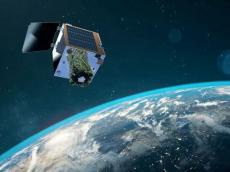|
|
TODAY.AZ / World news
UK hopes military satellite can boost space power
17 August 2024 [18:35] - TODAY.AZ

The UK military is about to launch its first ever dedicated Earth-imaging satellite, Azernews reports, citing BBC.
Called Tyche, the washing machine-sized spacecraft will have sufficient resolution to identify battlefield troop positions and vehicles.
It's a demonstrator that should be followed by a network of satellites this decade using a variety of sensors.
Some of these future spacecraft will be able to see through cloud and even eavesdrop on radio transmissions.
Tyche's ride to orbit is booked on a SpaceX Falcon rocket flying out of California. Lift-off is scheduled for 11:20 local time (19:20 BST).
The British mission will be ejected at an altitude of roughly 500km to begin what's expected to be a minimum of five years of operations.
UK forces have long benefited from the use of their own, state-of-the-art satellite communications system, called Skynet, but getting access to surveillance and reconnaissance imagery from space has largely required a friendly request to allies, particularly the United States.
And while the Ministry of Defence (MoD) has contributed funds in the past to projects in the UK commercial sector, Tyche will be its first wholly owned imaging capability.
Commissioned by UK Space Command and built by Surrey Satellite Technology Ltd (SSTL) in Guildford, the 160kg satellite will collect its imagery at optical wavelengths - in the same light we sense with our eyes.
It's designed to capture 5km-wide spot scenes on the ground and have a best resolution of 90cm.
This is by no means the best performance possible (some classified US satellites are reported to see features as small as 10cm across), but it fits with the British military's generalised needs.
Tyche was born out of a 2021 Space Command Paper and a 2022 Space Defence Strategy, which committed the last government to spend £970m over 10 years on a programme called Intelligence, Surveillance, Target Acquisition, and Reconnaissance, or ISTARI.
This set out a number of initial R&D efforts with the eventual goal of launching a sovereign constellation of military and national security satellites to orbit.
These spacecraft are intended to carry a range of technologies, among them radar sensors that can see the Earth's surface in all weathers and at night - a capability Ukraine has found invaluable in tracking invading Russian forces.
"This is the start of a journey," said Maj Gen Paul Tedman, commander of UK Space Command. "The space defence strategy lays out how we're going to become a meaningful space power by 2030.
"We're hoping to see many more launches of satellites in the coming months and years. Tyche is absolutely the beginning of that.”
SSTL has been working closely with UK Space Command on ISTARI and hopes to win further defence contracts, at home and abroad.
"Many other countries are setting up space commands," said Darren Jones, the manufacturer's head of defence business.
"There's lots of appetite around the world for space capabilities for defence purposes. What this Tyche contract shows for us is that we've got confidence from the MoD to deliver these types of missions, which can only help us in future with other nations around the globe."
Tyche is based on the company's Carbonite model, which can be assembled rapidly and at relatively low cost (the Tyche contract is worth £22m).
One interesting feature is its propulsion system which manoeuvres the satellite using water.
"The water goes through a thruster that heats it up to make superheated steam. That's how we get thrust and do station-keeping," explained chief technology officer Andrew Haslehurst.
"Tyche carries 10 litres. It's enough to get five-to seven years of in-orbit life."
URL: http://www.today.az/news/regions/251820.html
 Print version
Print version
Connect with us. Get latest news and updates.
See Also
- 16 January 2026 [09:00]
Coca-Cola trademark extended until 2035 - 16 January 2026 [08:00]
Everyday Inventions from Sweden - 15 January 2026 [23:27]
Dodge drops Hornet crossover amid weak sales - 15 January 2026 [22:26]
Amazon rolls out cloud service for European data sovereignty - 15 January 2026 [21:45]
Finland bans social media for under-15s - 15 January 2026 [21:23]
Baykar targets 25–30 P180 aircraft per year after Piaggio acquisition - 15 January 2026 [20:22]
London, Ankara signal deeper trade and defence cooperation - 15 January 2026 [19:21]
Minister Uralo?lu outlines 2025 achievements, 2026 infrastructure goals - 15 January 2026 [15:12]
Trump imposes 25% tariff on high-end semiconductor chips - 15 January 2026 [14:19]
US President Trump says Ukraine, not Russia, is delaying peace deal
Most Popular
 Azerbaijan launches industrial copper mining: Demirli opens up new opportunities
Azerbaijan launches industrial copper mining: Demirli opens up new opportunities
 Defense Ministry, Military Prosecutor sign plan to prevent violations in armed forces
Defense Ministry, Military Prosecutor sign plan to prevent violations in armed forces
 President Ilham Aliyev inspects reconstruction progress in Heyvali village, Aghdara district
President Ilham Aliyev inspects reconstruction progress in Heyvali village, Aghdara district
 Armenia publishes framework for TRIPP transit route
Armenia publishes framework for TRIPP transit route
 Armenia takes control of its borders as old dependencies from Russia unravel [INTERVIEW]
Armenia takes control of its borders as old dependencies from Russia unravel [INTERVIEW]
 Tehran warns of strikes on US bases across region
Tehran warns of strikes on US bases across region
 Armenia is reforming the army: revanchists are worried
Armenia is reforming the army: revanchists are worried
